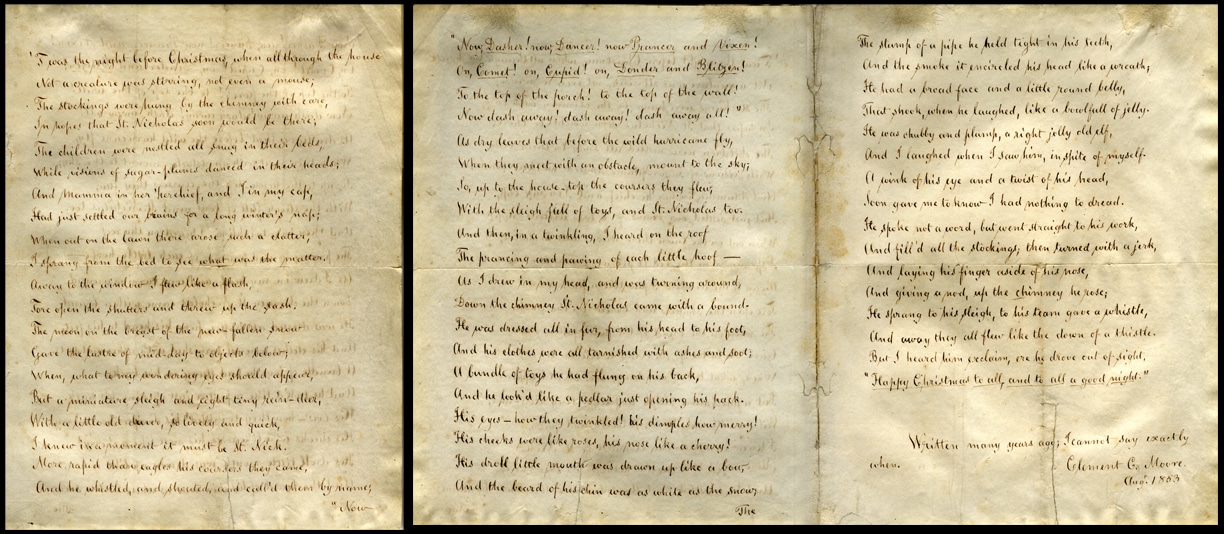
Whenever I read those five simple words, I feel as if a curtain has been deftly drawn aside, revealing the very essence of Christmas with its joyous blending of color and sound, memories and feelings. Under the spell of this poem, I always find myself responding to the magic and wonder of Christmas.
The stockings were hung by the chimney with care
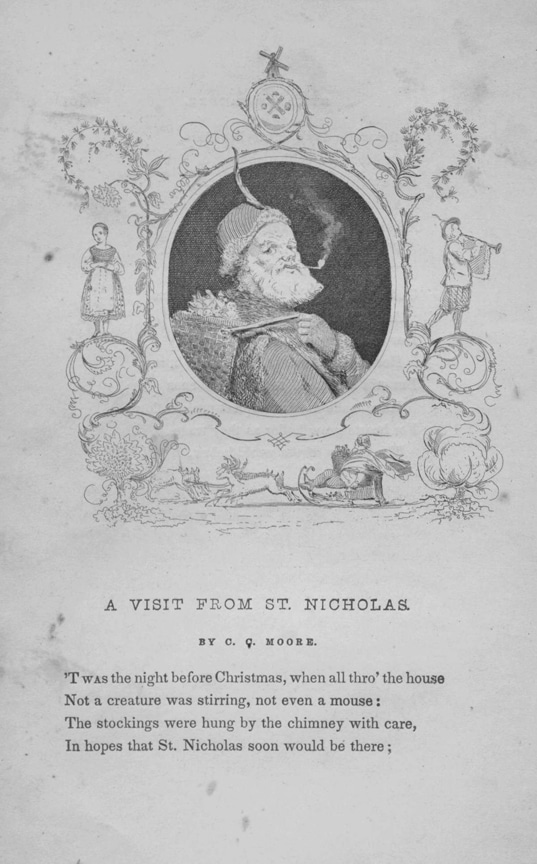 In hopes that St. Nicholas soon would be there;
In hopes that St. Nicholas soon would be there;
The poem’s author is Clement Clarke Moore, a theological scholar and professor of Oriental and Greek literature. The setting is New York City in 1822. But the poem offers readers the account of a parent who could be anywhere and a date that could be any and every Christmas Eve. This is a poem not of the intellect but of the heart.
And Mamma in her ‘kerchief, and I in my cap,
Had just settled our brains for a long winter’s nap—
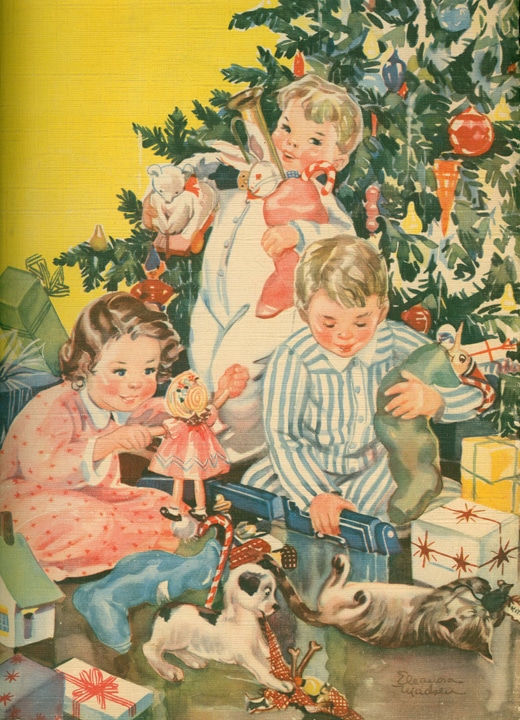 The story surrounding the poem tells that Moore composed it in his sleigh on his way to buy a turkey for charity. Once he was home, Moore wrote down the poem and recited it to his family that evening—Christmas Eve, 1822. Fortunately, the daughter of a friend heard his recitation and copied the poem into her keepsake album. The following year, she gave the poem to the editor of the New York Sentinel in Troy, NY, who published it in his newspaper on December 23, 1823 and annually after that. The poem’s popularity grew and it soon appeared in almanacs, broadsides, magazines, and books. Moore, however, did not acknowledge his authorship until 1837 when the poem was included in The New-York Book of Poetry.
The story surrounding the poem tells that Moore composed it in his sleigh on his way to buy a turkey for charity. Once he was home, Moore wrote down the poem and recited it to his family that evening—Christmas Eve, 1822. Fortunately, the daughter of a friend heard his recitation and copied the poem into her keepsake album. The following year, she gave the poem to the editor of the New York Sentinel in Troy, NY, who published it in his newspaper on December 23, 1823 and annually after that. The poem’s popularity grew and it soon appeared in almanacs, broadsides, magazines, and books. Moore, however, did not acknowledge his authorship until 1837 when the poem was included in The New-York Book of Poetry.
When, what to my wondering eyes should appear,
But a miniature sleigh, and eight tiny reindeer,
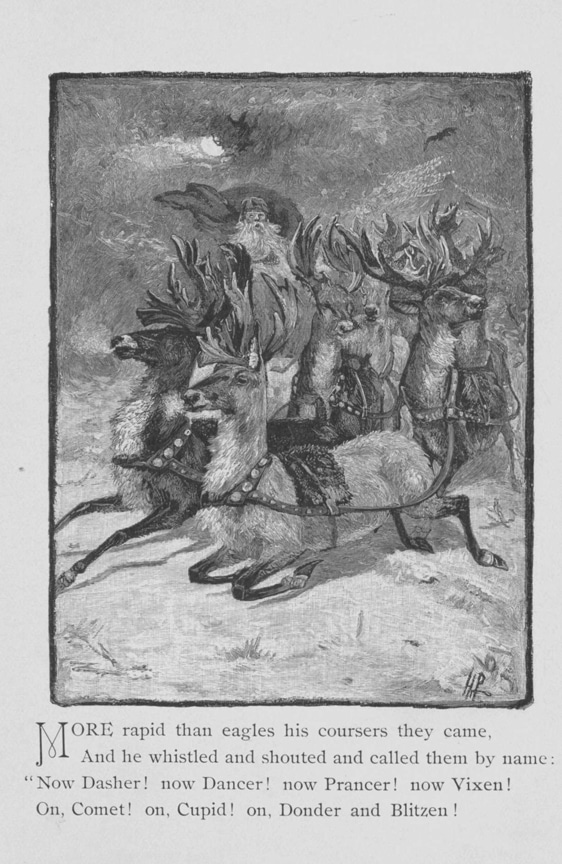 When Moore imagined his poem, he drew on contemporary legends and images of St. Nicholas, embellishing them and adding his own poetic touches. St. Nicholas, a fourth-century bishop in Turkey, was known for distributing secret gifts during the night. He was both a patron saint of children and of the Dutch inhabitants of New Amsterdam who called him Sinterklaas. In 1809’s Knickerbocker’s History of New York, Washington Irving described St. Nick flying over the treetops, bringing presents, smoking a pipe, and “laying his finger beside his nose.” An 1815 New York newspaper published a poem that introduced stockings filled with toys and the concept of gifts received as rewards for good behavior. And, in 1821, a small illustrated booklet, The Children’s Friend, depicted “Santeclaus” in a sleigh full of gifts guided by a single reindeer.
When Moore imagined his poem, he drew on contemporary legends and images of St. Nicholas, embellishing them and adding his own poetic touches. St. Nicholas, a fourth-century bishop in Turkey, was known for distributing secret gifts during the night. He was both a patron saint of children and of the Dutch inhabitants of New Amsterdam who called him Sinterklaas. In 1809’s Knickerbocker’s History of New York, Washington Irving described St. Nick flying over the treetops, bringing presents, smoking a pipe, and “laying his finger beside his nose.” An 1815 New York newspaper published a poem that introduced stockings filled with toys and the concept of gifts received as rewards for good behavior. And, in 1821, a small illustrated booklet, The Children’s Friend, depicted “Santeclaus” in a sleigh full of gifts guided by a single reindeer.
His eyes—how they twinkled! His dimples, how merry!
His cheeks were like roses, his nose like a cherry!
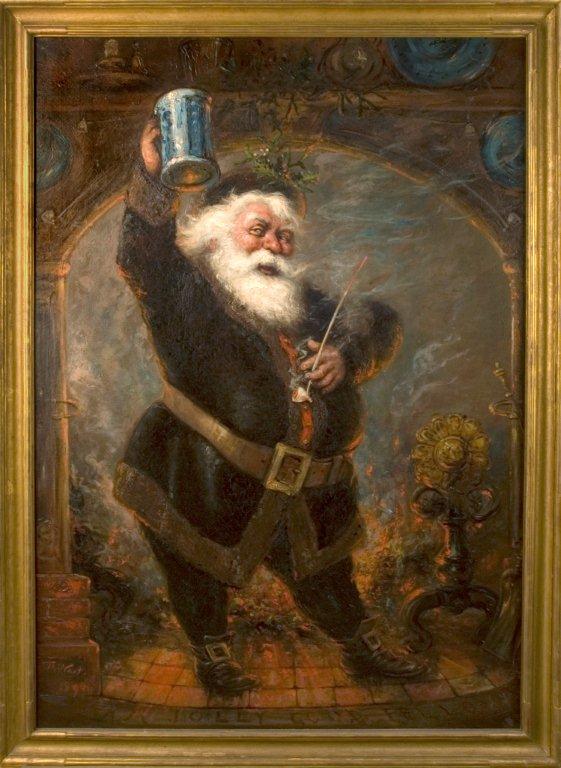 However, it’s Moore who absorbed elements of the Santa Claus legend and created not just a poem, but an indelible vision. This is Santa Claus, this is Christmas Eve. Moore gives us a team of eight named reindeer, a Santa Claus who descends down the chimney with a bundle of toys, who makes us laugh in spite of ourselves, and who is goodness personified. This is the Santa Claus who inspires artists year after year. One notable artist was Thomas Nast, whose depictions of Santa Claus appeared annually in Harper’s Weekly from 1863 to 1886, shaping our American image of Santa. Viewing Strong’s own oil painting, A Jolly Good Fellow, painted by Nast in 1874, is a cherished holiday tradition with the museum’s guests.
However, it’s Moore who absorbed elements of the Santa Claus legend and created not just a poem, but an indelible vision. This is Santa Claus, this is Christmas Eve. Moore gives us a team of eight named reindeer, a Santa Claus who descends down the chimney with a bundle of toys, who makes us laugh in spite of ourselves, and who is goodness personified. This is the Santa Claus who inspires artists year after year. One notable artist was Thomas Nast, whose depictions of Santa Claus appeared annually in Harper’s Weekly from 1863 to 1886, shaping our American image of Santa. Viewing Strong’s own oil painting, A Jolly Good Fellow, painted by Nast in 1874, is a cherished holiday tradition with the museum’s guests.
He sprang to his sleigh, to his team gave a whistle,
And away they all flew, like the down of a thistle.
While the original has been lost, four copies of the poem written and signed by Moore exist. The earliest copy is in the museum’s collection. Dated August 1853 when Moore was 74, it is a fragile but poignant connection to the author, the parent, and the believer in Santa Claus.
But I heard him exclaim, ere he drove out of sight,
“HAPPY CHRISTMAS TO ALL! AND TO ALL A GOOD NIGHT!”
 Hours 10 a.m.–5 p.m. | Fri. & Sat. till 8 p.m.
Hours 10 a.m.–5 p.m. | Fri. & Sat. till 8 p.m.